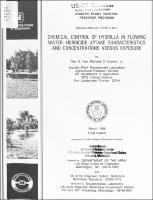Please use this identifier to cite or link to this item:
https://hdl.handle.net/11681/6283| Title: | Chemical control of Hydrilla in flowing water : herbicide uptake characteristics and concentrations versus exposure |
| Authors: | Van, Thai K. (Thai Khac), 1941- Conant, Richard D., Jr. |
| Keywords: | Diquat Endothall Fluridone Herbicides Hydrilla Aquatic plants Flowing water Aquatic plant control Vegetation Aquatic Plant Control Research Program (U.S.) |
| Publisher: | U.S. Army Engineer Waterways Experiment Station |
| Series/Report no.: | Miscellaneous Paper (Aquatic Plant Control Research Program (U.S.)) ; no.Miscellaneous Paper A-88-2 |
| Abstract: | Most alternative techniques for management of hydrilla [Hydrilla verticillata (L. f.) Royle] have been developed for lentic systems, and thus their use in flowing water is usually limited. Control of hydrilla in flowing water is difficult because the herbicide may be in contact with the plant for a matter of hours or minutes before being swept away by the current. This study was conducted to develop strategies for hydrilla control in flowing water. Specific objectives were: (a) to determine the susceptibility of the monoecious hydrilla to registered aquatic herbicides, (b) to provide information on the minimum contact time required for control of monoecious and dioecious hydrilla with diquat, endothall, and fluridone, and (c) to examine time-course uptake characteristics of these herbicides by hydrilla. All results presented in this report were from laboratory studies and should be verified by field trials in natural environments. Monoecious and dioecious hydrilla responded similarly to the aquatic herbicides currently registered for hydrilla control. Control of both biotypes was obtained with treatments of about 0.25 mg/𝓁 diquat under the conditions prevailing during these studies. Copper (Koplex) was effective at about 1.0 mg/𝓁. Endothall controlled both biotypes at about 0.5 to 1.0 mg/𝓁. The relationships between herbicide concentrations and contact time required for hydrilla control were investigated. For diquat, control of both hydrilla biotypes at 0.25 mg/𝓁 required a minimum of 2 days contact time under laboratory conditions. Similarly, 2 to 4 days of contact were required to control hydrilla with 1.0 mg/𝓁 endothall. When treatment rates were increased to 2.0 mg/𝓁 diquat or 5.0 mg/𝓁 endothall, the minimum required contact time was reduced to 6 to 12 hr depending on plant growth stage. Early growth emerging from sprouting tubers appeared to be more susceptible to herbicide treatments. The lethal concentration of diquat in plant tissue was estimated to be about 80 μg/g dry weight when hydrilla was treated at 0.25 mg/𝓁 diquat for 2 days of exposure. However, the lethal tissue concentration was found to vary with different herbicide lethal doses, probably because of the increasing amounts of adsorption to plant surfaces at higher treatment rates and shorter contact time. Similarly, a lethal endothall concentration of 75 μg/g was determined in hydrilla tissue after 72 hr contact to 1.0 mg/𝓁 ambient endothall. The bioconcentration factor for endothall uptake (which indicates how efficiently the herbicide is taken up by the plant) increased to a maximum of 77 at 4 days after treatment, as compared to a factor of 550 observed for diquat uptake under similar conditions. The ability of diquat to be taken up much more easily than endothall provides one possible explanation why diquat is effective in hydrilla control at a lower rate than is endothall. Uptake of fluridone by excised hydrilla tissue was linear with time when ambient fluridone levels were 0.1 to 0.5 mg/𝓁. However, a biphasic uptake curve was obtained at the high treatment rate of 1.0 mg/𝓁 fluridone. At this high rate of fluridone, a bioconcentration factor of 35 was observed at the end of the first phase of uptake 4 days after treatment, followed by a sharp increase to 115 after 11 days. These biphasic uptake characteristics suggested that a split application of the herbicide may improve fluridone uptake. Monoecious hydrilla appeared to be much more susceptible to fluridone than the dioecious biotype. Control of early growth from sprouting tubers of the monoecious biotype required 12 hr of contact to 1.0 mg/𝓁 fluridone, whereas a 4-day exposure to this same treatment rate was required for similar control of dioecious hydrilla. |
| Description: | Miscellaneous Paper |
| Gov't Doc #: | Miscellaneous Paper A-88-2 |
| Rights: | Approved for public release; distribution is unlimited |
| URI: | http://hdl.handle.net/11681/6283 |
| Appears in Collections: | Miscellaneous Paper |
Files in This Item:
| File | Description | Size | Format | |
|---|---|---|---|---|
| MP-A-88-2.pdf | Miscellaneous Paper A-88-2 | 4.23 MB | Adobe PDF |  View/Open |